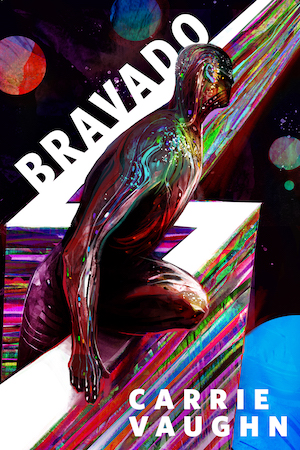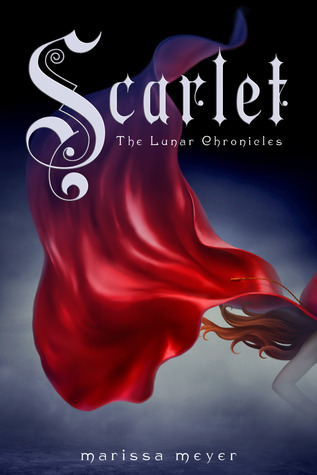Fairytale updates—like fanfiction—start with a built-in comfort level; you already know the characters and storyline. Is it easier for the author to build from archetypes or do they have to work harder to bring anything new to the table? In Cinder, and now Scarlet, Marissa Meyer tackles some of our most prevalent folklore with grace and invention. She brought freshness, warmth, moon colonies and androids to the Cinderella story, without losing any of the essential charm, timelessness or integrity. So I jumped into Scarlet, the sequel, with both eagerness and trepidation; it didn’t start with the same characters or setting—in fact it was half way across the world from New Beijing—and I cared a little less about Red Riding Hood. The sequel hopped between Scarlet and Cinder’s stories almost every chapter and while the new point of view was a little slower to ramp up, the chapters that continued the Cinderella story more than made up for it.
In the very first chapter, the juxtaposition of “olde-worlde” fantasy elements like French honorifics and old-timey “taverns” with the futuristic setting was noticeable enough to keep me from sinking entirely into the narrative, but it took me a while to pinpoint whether it was disharmonious or intriguing. Towards the start, trying to adhere to the fairytale Meyer was drawing from seems to hold her back, and details such as the red hoodie seemed unfortunately unnecessary and obvious. It wasn’t until the last third or so of Scarlet’s story, when she and Wolf hit Paris, that it finally clicked home for me. This was true of a lot of Scarlet’s story; it took me much longer to be invested, but the Parisian payoff more than delivered—while punching me repeatedly in the lungs. Fortunately most chapters switched POV, so we continued to follow Cinder’s story as well, which provided much needed momentum for the first half. Watching the two stories, set on collision course train wreck levels of eye-catching, I somehow still found myself jumping in surprise and pleasure when (spoiler) the two girls finally meet.
In Cinder the toys, tools and trappings of the future—ships, androids, netscreens and portcoms, ID chips—felt integral to the story of a cyborg Cinderella, an evil Queen who enchants people with bioelectricity, and Cinder’s metal foot replacing the traditional glass slipper. In Scarlet, starting out in a small town in Europe, flying her fresh fruit and vegetables in a spaceship to a local tavern and being paid in “Univs” feels disorientating, as if I saw an Amish girl on the subway, playing Angry Birds on an iPhone. Scarlet, however, shows Meyer’s grasp of character growing by leaps and bounds; with significantly fewer brushstrokes, Meyer paints appealing and much more complex characters.
Scarlet also helped me understand Cinder more in retrospect; I’d been curious about the choice to leave the Prince as something of a blank-slate character, whether it was lack of ability on Meyer’s part to flesh him out, or intentionally leaving him something of a cipher so that we focused on what is obviously more important to Meyer: these incredibly strong young girls. Seeing how masterfully Meyer builds Wolf, Scarlet’s love interest, and his internal conflicts, I become more convinced that Kai was intentionally left blank. In fact, it prompted me to consider whether she was, perhaps almost subversively, hinting to the reader that Cinder’s teenage crush on the Prince might be replaced by a more mature interest in Thorne. The vain, silly criminal cadet who claims to be a Captain certainly was one of the highpoints of this book for me; and possibly a much more appealing romantic option for Cinder.
Where previously we’d only seen flashes of New Beijing, Scarlet helped flesh out the world (and, with the brief flash she gives us at the end of the moon, it’s fair even to say worlds) Meyer is building. Meyer’s skill with description and immersion improved hugely, and some of her language was quite visceral and gripping. Early in the book she makes the urgency and terror of the Grandmother’s kidnapping hit home with her description of a piece of cheesecloth on the kitchen counter, dotted with blood, with her ID chip in it. It’s a small moment in the bigger story, but it ties in so many elements of the world and hints at all the ways the characters are tracked and threatened through their ID chips, while painting this moment, shocking in the combination of the domestic ordinariness, the bright red of violence and the futuristic technology. I was swept up in the language and visuals at multiple moments in the book, though possibly the most noteworthy was the first time we see the Louvre, through Scarlet’s eyes. I had a sudden understanding of how wrecked Paris was and both how devastating and threatening the ruined beauty of the city was. Meyer used the destroyed, looming grandeur to illustrate brilliantly the contrast between the sweetness and beauty that Lunars project and the horror and ugliness underlying it.
Scarlet’s struggle to keep her mind clear and under control is neatly paralleled with Cinder’s conflict between using her powers and not manipulating others. Both girls fight to retain their humanity and power in the face of overwhelming odds; even when they are betrayed and in increasingly dire odds they don’t give up and often come up with kind of brilliant fixes. When Cinder plugged herself—and Iko—into the ship to escape, I was practically gaping, and not just because Iko remains one of my favourite characters. I was certainly a little heartbroken when Scarlet realizes Wolf lied, or when Cinder had to abandon her dead sister’s ID chip, realizing that her own step-mother had actively tried to work against her. Meyer does an increasingly impressive job of depicting strong, sympathetic young women who are silenced, hunted, victimized and villainized. These themes certainly have a place in a wider dialogue about disenfranchised groups, but are, I think, particularly resonant in young adult literature as teenagers wrestle with experiencing the world and being told they are too young, too inexperienced, and generally suspect. Most teenagers can relate to feeling unheard, not respected and powerless, and the way these characters fight through and grab at the ability to make their own choices with both hands, metal and flesh, is deeply satisfying. While the beginning of the book may have suffered from second book syndrome, the ending was a great example of how to wrap up enough to be gratifying while upping the stakes and leaving me excited for the sequel.
Scarlet and Cinder spend most of the book racing towards answers, and readers will find themselves racing through the book even more quickly, but, layered into the at times predictable structure of a fun fairytale retelling, were the beginnings of some really interesting questions. Fairytales are deeply embedded in our collective consciousness, and readers will rarely come to an adaptation without baggage, but does that do half the work for an author—with a prebuilt foundation for their story’s house—or is it an almost impassable brick wall of expectations? Just as Scarlet had to repeatedly choose between a relatively idyllic life and dangerous answers, or as Cinder spent most of the book trying to reject her responsibilities and burdens, so do we revisit these stories for comfort and lack of surprises, or to have our perceptions altered and shaken up? Are they a sharp, jagged-edged mirror through which we reexamine our lives, or a soft snowy blanket into which we sink and hide?
Scarlet is published by Feiwel & Friends. It is available now.
Nina Lourie would quite like a metal brain replacement, but thinks Cinder’s lie-detector would probably ruin her social life.










